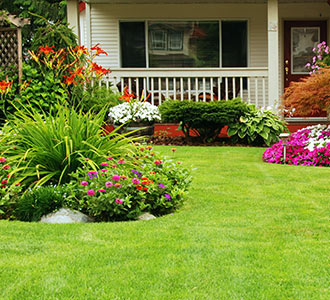How To Avoid Lawn Fungus Disease
The soil and organic matter in your lawns provide a perfect environment for fungus and bacteria. There are many spores and seeds already present in your lawn and they are usually harmless and dormant. But they can come alive and destroy your grass if the weather and soil conditions are favourable. A wet or dry spell, warmth and shade, and an imbalance in the soil can easily bring these spores out of their dormancy.
Signs of Lawn Fungus
- Small and thin patches of discoloured and frayed grass leaves
- Yellow, brown, or white rings on the grass that grow over time
- Wet, dark, and greasy looking grass that shows signs of decay
- Black, gray, or pink powdery substance on and around the grass
- Different coloured spots and marks on the grass leaves and stems
Common Diseases
- Brown Patch – You can expect this lawn disease when the weather is hot and humid.
- Dollar Spot – This fungus only appears during spring when the night time weather is cool and damp with dew.
- Fusarium Blight – You can expect this fungus to appear if water is scarce and the weather conditions are hot and dry.
4 Easy Steps to Avoid Lawn Fungus
Not all fungi and microbes are harmful, as some can facilitate the breakdown of organic matter into the soil. It is important to maintain the balance and control the amount of microbes present in the soil. Some fungi actually keep microbes at bay by providing strong competition. You only face problems related to grass fungus when pathogens become dominant in your backyard.
Here is what you can do to avoid this problem from affecting your lawn:
Use the Right Grass – Your grass will present strong competition to fungi and limit their growth if it is strong and healthy. You should plant grass that is ideally suited for your weather and soil conditions. Your local lawn care professional can help you choose the most resilient grass species available for the area.
- Test the Soil – The imbalance in soil condition often leads to fungal infestation and other such problems. You should test your soil’s nutrient value, pH balance, and other nutrient levels immediately after you see signs of infestation.
- Aerating and Dethatching – When you aerate the soil, you loosen it and allow air, light, and water to penetrate below the surface. This helps keep harmful microbes and fungi dormant. Dethatching removes the surface layer of organic matter to allow the soil to breathe as well.
- Mowing and Hedge Trimming – If you allow your lawn grass and hedges to grow wild, you are at greater risk of inviting grass fungus. Overgrown grass and hedges can create a favourable environment for these microbes and encourage growth.
Regular lawn maintenance will also help you avoid grass diseases. Lawn maintenance companies offer seasonal contracts and can come to your property at a predetermined time to make sure your grass is well-maintained and healthy.
If you want to know more about lawn disease and looking to hire a reliable company for lawn care, don’t hesitate to contact us at Greenbloom. You can also call us at 647-500-5263.

 Use the Right Grass – Your grass will present strong competition to fungi and limit their growth if it is strong and healthy. You should plant grass that is ideally suited for your weather and soil conditions. Your local lawn care professional can help you choose the most resilient grass species available for the area.
Use the Right Grass – Your grass will present strong competition to fungi and limit their growth if it is strong and healthy. You should plant grass that is ideally suited for your weather and soil conditions. Your local lawn care professional can help you choose the most resilient grass species available for the area.




